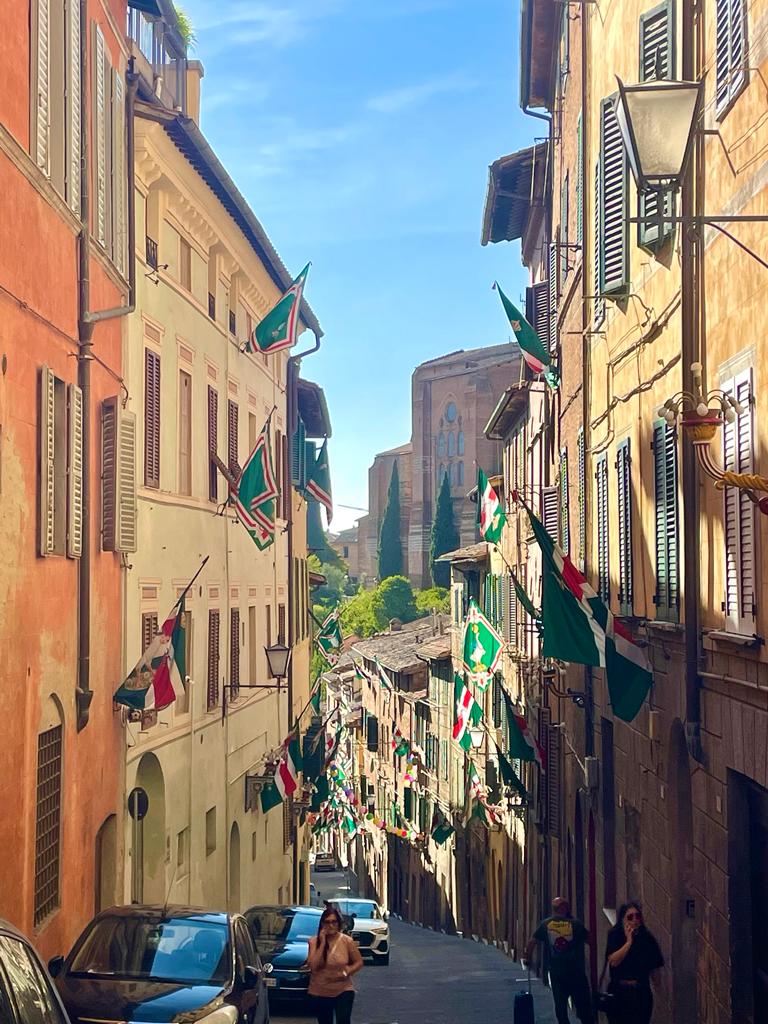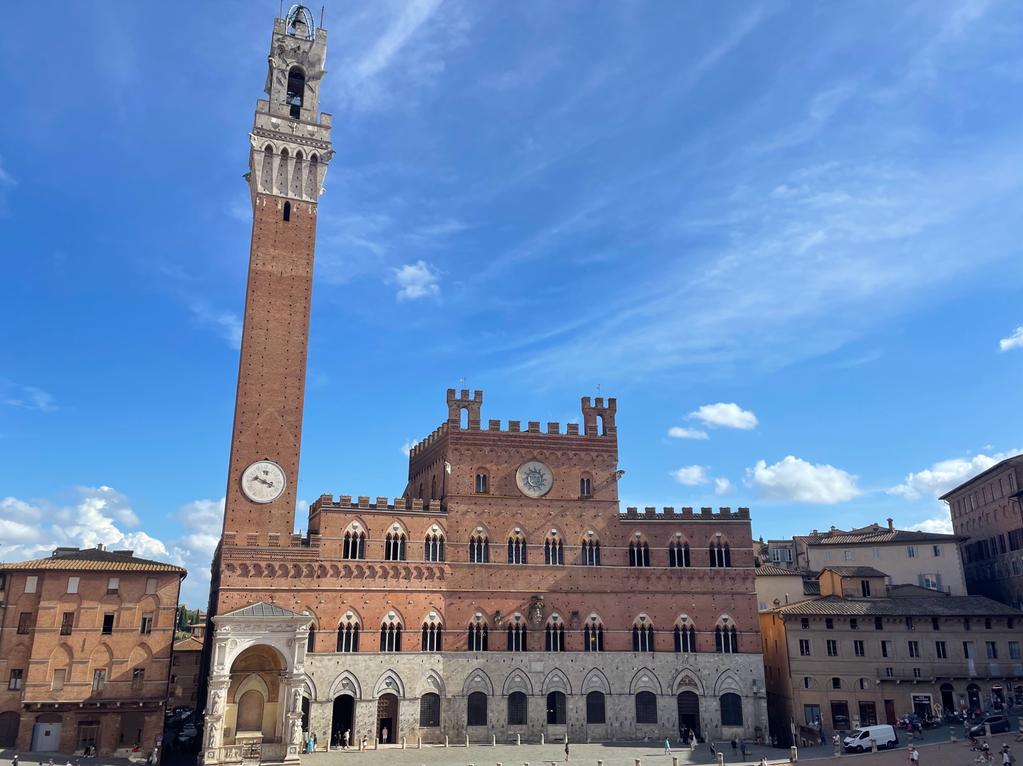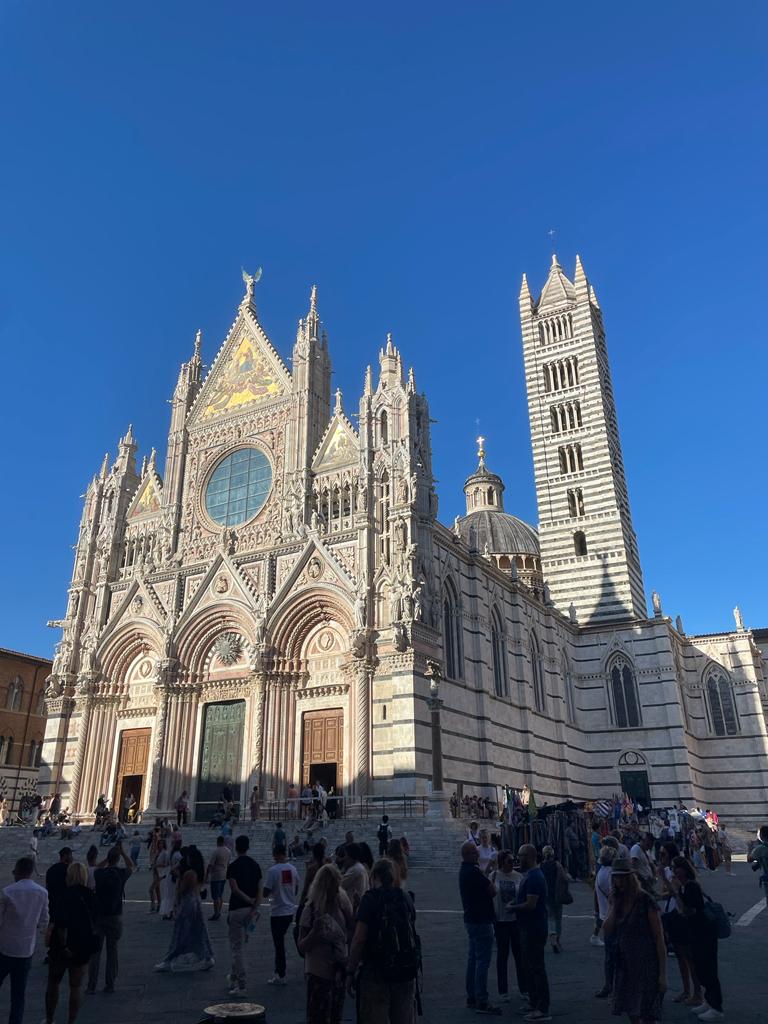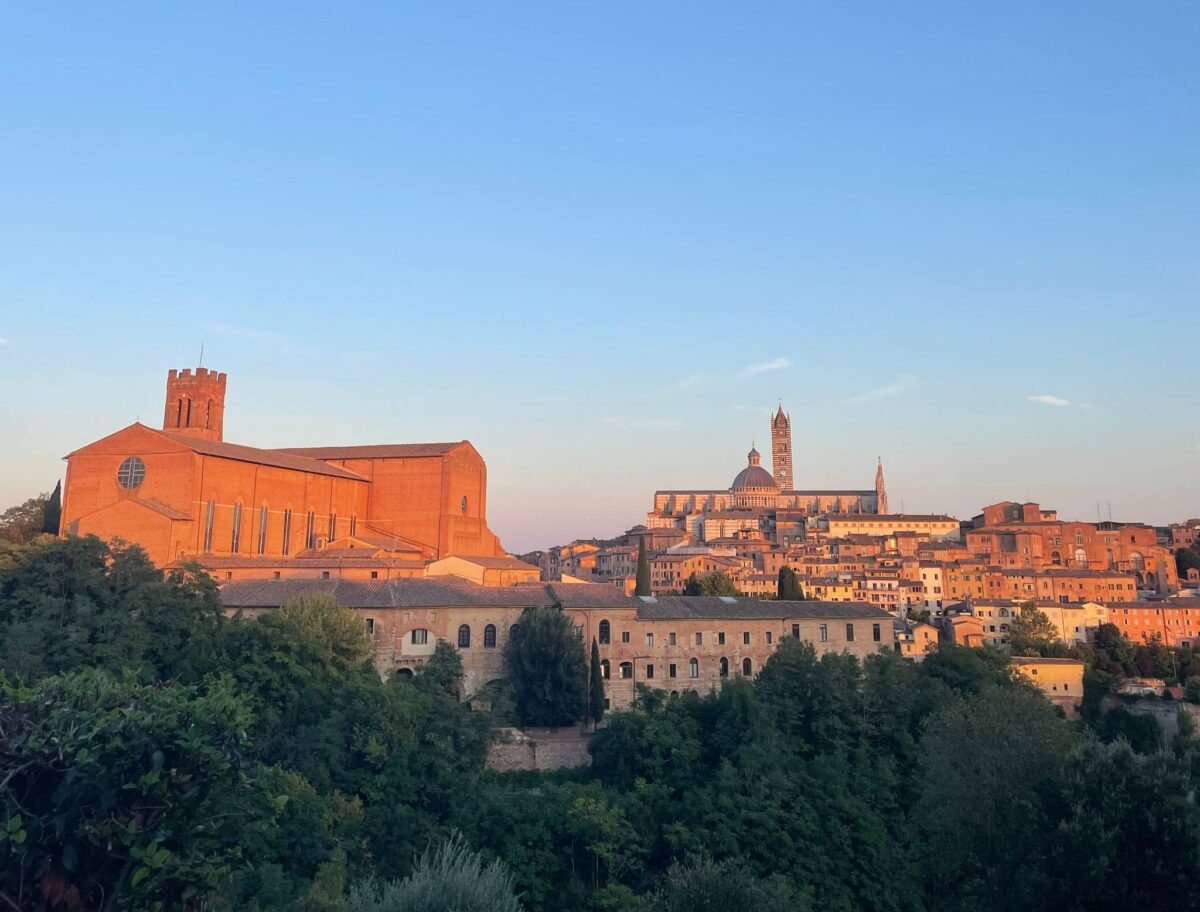By Gwyn Angel
The prospect of spending a year abroad is a daunting, looming, even terrifying, yet overwhelmingly exciting thought. Pre-arrival, I was tasked by a good friend to read ‘A Month in Siena’ ahead of my three months in the city. As I sat reading on a particularly turbulent EasyJet flight, the book sent my brain into a frenzy of foresights of sitting in front of paintings, cathedrals, statues, relics, and frescoes, just as Hisham Matar does in his memoir of Siena. I was also very excited, naturally, to indulge in copious amounts of Aperol Spritz, gelato, pasta made by a ‘nonna’ and any other quintessentially stereotypical Italian phenomena. While both activities occupied many hours of my first few weeks here, one of the most beautiful things I discovered upon arrival, is the joy I find in observation, and the things which you can learn when you take time to simply exist alongside the Sienese people.
The stereotypes of Italians aren’t untrue, but there is a particular duality in the Sienese way of life which I noticed in my first month or so here. The first side of this coin is the unique passion which can only be found within Siena’s city walls. This comes from loyalty to one of the 17 ‘contrada(s)’, which are the neighbourhoods of the old city. Each contrada has an individual set of colours, name, flag, and representative animal, for example, the ‘Bruco’ is the caterpillar district, whose colours are yellow and green. Beyond the ancient city walls are the suburbs, train station, and other mundane architecture, but within the four gates lies a tradition which dates to the late 12th, early 13th century. It is this unusual aspect of the city which creates a sense of an entirely independent country within Italy, with their own rules and traditions. Belonging to a contrada is not unlike being a national of one country compared to another, and there is a process which exists for if you moved to Siena and wanted to join a district. Each Sienese individual is born into a contrada, normally that of their parents, but again, like in the case of a nationality, if you are born in say the ‘Lupo’ contrada then that is the one you are associated with, unless you undergo an official switch. I have even been told stories of couples who live outside their district (which is very common due to house prices) who rent a property within their contrada solely to give birth, thereby ensuring their child is born into the ‘right’ one. It is honestly impossible to articulate the level of gravity this aspect of Siena holds, and during my first visit to the city in 2020, I didn’t even catch a glimpse of it.

The most important days of the year in Siena are the days of the two Palio races. The Palio is a bareback horse race, where a randomly selected ten of the seventeen districts race around the Piazza del Campo (the main square) competing for a year of fame and admiration. Honestly, they spend the next year boasting and bragging. It is worth googling and watching videos of the race, as it’s hard to explain just how manic this event is; type into google, ‘August 2023 Siena Palio race’. There are rules which date back centuries, such as: a member of the contrada must sleep in the stable with the horse the night before the race, the horse must be brought in to be blessed in their contrada chapel, and also, one which seems particularly bizarre, is that the contrada can win if the horse crosses the finish line without the rider on its back. In fact, that is exactly what happened in the August race this year. It is a race steeped in fierce tradition, rigged to ensure enemies don’t win, riders are bashed off horses, and most importantly, that your horse doesn’t come second, as that is considered far worse than placing last.
Now, relevance to my point. The way in which the Sienese celebrate their contrada, or their victory, is through a series of parties, parades and demonstrations; manifestations of pomp and circumstance which continue throughout the months following the races, at any hour of the day. When we arrived, we heard a lot about contrada parties, filling the streets and squares of Siena with people of all ages celebrating in their shared pride. I had not quite realised the extent of this ‘campanilismo’ (the Italian word for loyalty to your place of origin) when after an Erasmus party, we heard this booming sound of drumming making its way towards us. We were in complete awe, that at three o’clock in the morning, fifty or so people could be seen marching through Siena, and not a single person leant out of their window to tell them to shut the fuck up. Something that you certainly would not see in the streets of Durham or London. It is clear that these ancient traditions still carry vast weight in modern Sienese lives and provide a sense of purpose to this otherwise idle existence. These little moments became semi-regular, as increasingly, I would finish a run, or would be on my walk home and find myself being led by the Pied Piper like a rat through the streets of Siena following the faint sound of drumming. It became obvious that you absolutely do not want to be driving in the centre of town at 7.10pm on a Tuesday evening during August and September. Or a Wednesday, or Thursday, or Friday for that matter, as the streets are so often occupied by parades. They vary from small processions to mass displays which fill the streets with the echoing, singing and eager tourists (including myself) lining the street walls, phones in hand, capturing these truly wonderful and weird moments. I am incredibly fortunate to have started my time here at this point of the year, as following the Palios of July and August, September is dedicated to celebration and demonstration. It truly shaped my first month here.

The other side of the Sienese is the, again stereotypical, assumption of Italians being very laid-back, never rushing or hurrying, just living a slow, contented life. As a Brit abroad, you can imagine my perpetual frustration, as the Italians are honestly always very, very, late. However, with a little open-mindedness, there is such beauty and peace that can be found in indulging oneself in this way of life. I have, therefore, been able to nurture my love for the Aperol Spritz, and combine this passion of mine, with the study of the Sienese people. If you are someone who has watched the 2010 film, ‘Eat, Pray, Love’ then you are probably familiar with the phrase ‘la dolce far niente’ – a phrase which means ‘the sweetness of doing nothing.’ However, this is a phrase that exists well beyond Julia Roberts’ travels in the film and is truly an encapsulation of a way of life, arguably an entire national identity. My two housemates and I have found ourselves just ‘popping into town’ and six hours later we decide we should probably go home, time having been completely warped by hours of idleness and people watching. One of them, Lily, has fallen completely in love with the elderly of Siena (which sounds weirder than it is) – simply watching them in their natural habitat, often chatting, or reading a newspaper and drinking an espresso. To sit and observe the Sienese people is akin to observing painting in a gallery or awnings in a church. Granted, up until November, this is confronted with the thousands of tourists wandering painfully slowly through the city. But honestly, who can blame them – it is a city that deserves admiration and observation.
Before I move onto a few recommendations, I have a story which I feel combines these two features of Siena perfectly. One evening, during a run through the city (which is in itself a pretty extraordinary experience) I came across a hidden church. Its dome was being touched by the last of the day’s sun, leaving a spectacular golden glow. I ran down the road to take a picture, when once again, as I got closer, I could hear this faint, and by then, familiar, sound of drumming. After a bit of hunting, I found a young boy practising drumming, alongside two others practising their flag bearing. This was more proof of the time and attention given to the parades. My eyes panned across the square I now found myself in, to find a group of six old men, sitting in the street around a little table, laughing and conversing. To find such a unique and beautiful snippet of civilisation in a backstreet of a city, just metres from the staggering number of crowds that fill Piazza del Campo, was a moment that truly illustrates what it is to simply exist in Siena. It’s the dedication to a contrada contrasted with a beautiful manner of being. Learning to appreciate these little snippets during time living abroad is a challenge, but also a blessing. Life in the UK, well for me at least, tends to be fairly fast paced, but now, where my downtime used to be a movie with housemates, it is merging into time spent discovering the little wonders of Siena. Slowing down is a magical and completely liberating feeling.
Some recommendations if you ever find yourself in Siena. Bocconcino does delicious sandwiches – think pesto, ham, burrata, and anything else you could possibly want. Much like any other popular tourist destination, you do pay for a view, but an Aperol at Le Grand Café is a must, as it comes with fresh Italian aperitivo bites and sits in the Piazza Del Campo, which, despite being busy, is a ‘must-see’. Similarly, a glass of sparkling wine at Il Battistero places you at the base of the back of the Cathedral, so in my opinion it’s money well spent. Naturally, a visit to the Cathedral is a necessity, alongside the Pinacoteca Nazionale di Siena, a museum full of art, and often exhibitions. In the main square is the Palazzo Publicco, in which you can find arguably the most significant and famous piece of art in the city, ‘The Allegory of Good and Bad Government’ by Ambrogio Lorenzetti, which is well worth seeing. The Basilica di San Francesco and Basilica Cateriniana San Domenico are another two beautiful churches hosting slightly creepy but significant relics. If you do make the trip to the Basilica Cateriniana San Domenico, and continue your walk out of the centre, you will find the ancient Fortezza (fort) and also a café which sits on a viewpoint unlike any other I have found in Siena. Every Wednesday morning you will find a market by this old fort, and despite hosting lots of pickpockets, it’s full of locals; and if you hunt you can find some beautiful things. I also came across a flea market one Sunday, sat directly behind the Piazza del Campo, in Piazza del Mercato, which felt incredibly authentic; not a card machine in sight. But, my best piece of advice to anyone visiting Siena (or Italy in general) is a rule I was once told and which I adamantly try to live by. When in Italy, “keep looking up”, and always walk into an open door. Granted, I am by no means suggesting you walk into some unfortunate family’s home, but if you see a church, museum, Cathedral or even a gelateria door open, just walk in.



